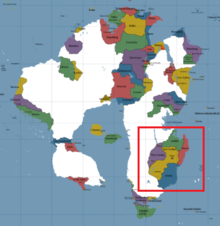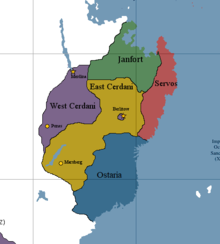Cerdani Democratic Republic
| This page is a work in progress by its author(s) and should not be considered final. |
| The Cerdani Democratic Republic East Cerdani
|
|||||
|---|---|---|---|---|---|
|
|||||
| 'Motto: '"Workers of all nations, Unite!" | |||||
| Anthem: "Risen from Ruins" | |||||
Location of East Cerdani
|
|||||
Local map of East Cerdani
|
|||||
| Region | The East Pacific | ||||
| Capital and largest city | Berlitow | ||||
| Official languages | None | ||||
| Recognised national languages | English | ||||
| Demonym | Cerdan | ||||
| Government | Unitary One Party Socialist State | ||||
| - | General Secretary | Erich Honecker | |||
| - | Head of State | Ernst Ulbricht | |||
| - | Head of Government | Hristov Zhivkov | |||
| Legislature | The People’s Chamber | ||||
| History | |||||
| - | Constitution Adopted | 1922 | |||
| Area | |||||
| - | Total | 749,150 km2 289,248 sq mi |
|||
| - | Water (%) | 2.4% | |||
| Population | |||||
| - | 2016 estimate | 126.1 million | |||
| - | Density | 436/km2 1,129.2/sq mi |
|||
| GDP (PPP) | 2016 estimate | ||||
| - | Total | $295.34 billion | |||
| - | Per capita | $2,339 | |||
| Gini (2016) | 11.95 low |
||||
| HDI (2016) | 0.885 very high |
||||
| Currency | East Cerdani Dollar ( CED) (CED) |
||||
| Date format | dd ˘ mm ˘ yyyy | ||||
| Drives on the | left | ||||
| Calling code | 37 | ||||
| ISO 3166 code | CDR | ||||
| Internet TLD | .cdr | ||||
The Cerdani Democratic Republic, often referred to as East Cerdani, is a Unitary One Party Socialist State located in Southeastern Gondwana. The capitol and largest city is Berlitow and is the main cultural and commercial centre.
Contents
History
Socialist Revolution
Constitution of East Cerdani
Modern Era
Geography
The total land area of East Cerdani is 749,150km² of land including the natural, reclaimed and artificial land. A dormant Volcanic Field is located in the southwestern portion of Cerdani and the highest point in Cerdani, Peak Communizma, which reaches a height of 1917 meters above sea level is located in this field.
Climate & Weather
East Cerdani has a Mediterranean climate with semi-arid influence. East Cerdani is generally very sunny, receiving around 164 clear days annually. In the winter the temperature is mild with daily highs averaging around 20 °C (68 °F). Most of the yearly rainfall falls throughout winter. In the summer months, Cerdani averages 32–33 °C (90–91 °F), with some days over 40 °C (104 °F). Both West and East Cerdani have virtually the same weather conditions.
Ecology
The ecosystems of Cerdani are ecologically diverse, ranging from heavy forests to rolling grasslands with numerous endemic species.
Government
The Cerdani Democratic Republic is self-described “dictatorship of the proletariat” where the workers hold majority of the power. The current system is based on the principles of a Soviet Direct Democracy and Democratic Centralism. The People’s Chamber is the unicameral legislature of the Cerdani Democratic Republic and is where representatives of the workers openly debate various laws and economic plans. The Workers are represented through their Vanguard Party, The Communist Party of Cerdani.
Foreign Relations
Position towards West Cerdani
The Cerdani Democratic Republic has pressed for re-unification over the years and are strongly objected to the Cerdani Republic's claim to represent the whole of Cerdani. East Cerdani does not officially recognise the West Cerdani Government and they maintain no formal diplomatic relationship. According to the West Cerdani Wallsten Doctrine, West Cerdani will not diplomatically recognize any country that recognises East Cerdani sovereignty.
Military
Main Article: National People's Army
The National People's Army are the professional military forces of the Cerdani Democratic Republic. All troops in the National Defense Forces are volunteer only and enlistees must be a citizen or permanent resident. Conscription is currently not enforced though it can be in times of emergency. The National People's Army is considered one of the most professional and best prepared military forces in the world. The NPA consists of the following branches:
Army (Land Forces) Navy (People's Navy) Air Force (People's Air Defence)
Economy
The East Cerdani economy is a centrally planned and managed economy with the prices of most goods and services being set by central government planners. The state establishes production targets and prices and allocates resources, codifying these decisions in comprehensive plans in liaison with the workers unions. These plans are then enforced in order to ensure they are met. Majority of workplace in East Cerdani are owned collectively by their workers, with only a few key industries having governmental oversight. The current economic system is based on scientific socialism. The current Five Year Plan is due to end in 2018 and be replaced in the same year.
Global Trade
Imports & Exports
People & Culture
East Cerdani is home to a collection of both local and international cultures. East Cerdan Citizens are typically described as very loyal and hardworking.
Ethnicity & Population
The population density in East Cerdani is around X per square kilometre. The 2015 census has indicates that the population is trending upwards slowly is estimated to be around 126.1 million. Majority of the population is Human, however large Vulpine and Feline populations exist. Roughly 77% of the population is Human with Felines accounting for about 16% of the population and the remainder being either Vulpine, hybrids or other species. Approximately 92% of the population live in urban areas with the remaining living in non-urban areas.
Religion in East Cerdani
The right to freedom of religion in private is guaranteed in the East Cerdani Constitution. Despite this the government officially describes Cerdani as an Atheist State and promotes atheistic propaganda. Roughly 78% of the population is Atheist or Irreligious with the remainder either following Vayan Catholicism or Christianity.
Languages
English is the national language of East Cerdani. According to the 2017 census, English is the only language spoken for close to 71% of the population while the next most common language being spoken at home is Codexian (15.9%) and then Unonian (15.1%).
Architecture
Sports
Art & Music
Infrastructure
Personal transportation by private automobile is extremely rare in East Cerdani, instead many citizens walk, bike or take public transport. All automobiles in Cerdani are electric and are manufactured locally, imports are strictly forbidden. East Cerdani's omnipresent public transport system is a colossal network comprised of automated tram, rail, subway and monorail lines.
Aviation
The civil aviation industry is one of the few industries with oversight and assistance from the East Cerdani Government. The national airline of East Cerdani is Cerdani International
Energy & Utilities
All of the water in Cerdani comes from either recycling or natural underground springs.
Cerdani uses a low amount of energy per-capita compared to other countries and has been aiming for zero carbon emissions by 2020. Since 2003 Cerdani has been powered entirely by geothermal power. Backup power units include wind-farms and an old nuclear powerplant.
Healthcare & Social Services
East Cerdani has funded extensive development of social services and insurance for workers over the years. All citizens have access to universal, free medical service and there is a wide network of free health resorts for the use of the working people.
Education
Citizens of the East Cerdani have the right to education. This right is ensured by universal, compulsory elementary education, including higher education, being free of charge. The state typically pays stipends for the overwhelming majority of students in the universities and colleges. Many of the collective factories and farms offer free vocational, technical and agronomic training for the working people.




